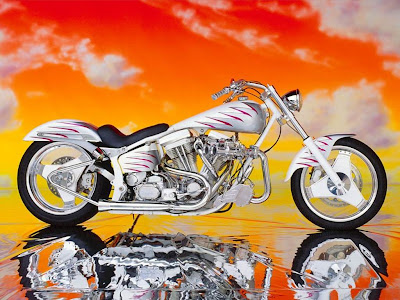Owning a Harley-Davidson means owning a piece of American history. The proper name contains the hyphen since it is actually a combination of the last names of the original designers/owners, William S. Harley (who drew up the plans for the original engine in 1901 at the age of 22) and his childhood friend Arthur Davidson.
After working for the next 2 years to finish their "motor-bicycle", they realized that this first motor was not powerful enough to climb the hills around Milwaukee without assistance. Without being discouraged, they quickly wrote it off as a valuable learning experiment.
The new and improved model was the first real Harley-Davidson motorcycle. The "boys" received help with the bigger engine (a 405cc) from Ole Evinrude. This bigger engine took their design out of the motorized-bicycle category and helped to define what a motorcycle should contain.
Their work space at the time was a 10 x 15 ft shed located in the Davidson family's backyard. The new prototype was used to compete in a Milwaukee motorcycle race at State Fair Park on September 8, 1904, where they finished fourth. This was the first historically documented appearance of a Harley-Davidson motorcycle.
By January of 1905, bare Harley-Davidson engines were being offered for sale to the do-it-yoursef crowd. It took until April for limited production to be in place. They sold only 3 bikes the first year.
The first factory was built in 1906, it was a 40 x 60 single-story wooden structure. They produced about 50 motorcycles that first year. By 1907, they expanded to include a second floor and production increased to 150 motorcycles. This original location, although the structure has been expanded and even redesigned, remains the corporate headquarters today.
Around this period from 1907 to 1909 is also when they first started selling motorcycles to police departments. This market continues to be an important part of their business today.
By February 1907, Harley-Davidson had a prototype model 45 degree V-Twin engine. This prototype was displayed at the Chicago Automobile Show. These first V-Twins had nearly double the power of the first singles and could achieve a top speed of about 60 mph. By 1909, production jumped to 1,149.
1911 brought the smaller, better performing V-Twin model that would be used in the majority of bikes produced after 1913. Demolition of the current factory and construction of a 5-story reinforced concrete and brick factory had been completed by 1913.
By 1912, there were 200 dealerships in the US and sales to Japan were growing. By 1914, Harley-Davidson was the dominant brand in the motorcycle racing circuit since their design had them pulling ahead of the Indian.
By 1920, Harley-Davidson was the largest motorcycle manufacturer in the world. Their motorcycles were being sold by dealers in 67 countries. Production that year was 28,189 machines.
Harley's have been used by the military during every war from the Pancho Villa Expedition (a.k.a. the Mexican Expedition) from 1916 to 1917 to World War II. During World War II, over 90,000 military motorcycles were produced, many of which were provided to allies.
A new motorcycle with many features of BMW's side-valve and shaft-driven R71 was requested by the U.S. Army. As a direct result of this request, the 1942 Harley-Davidson XA was born. This was completely different than any prior Harley-Davidson engine.
These XA cylinder heads ran 100 °F cooler than the V-twins. It was during this time that the Jeep replaced the motorcycle as the primary general purpose vehicle so only a limited number of Harleys XAs were ever built. The XA remains the only shaft-driven Harley-Davidson ever made.




